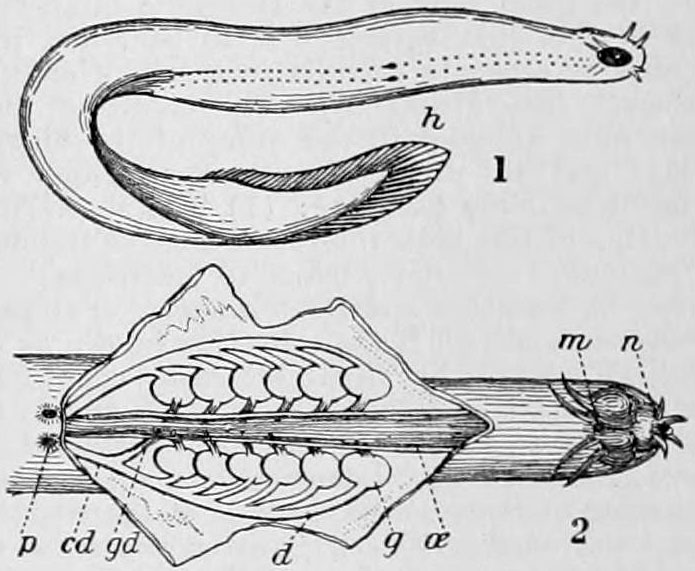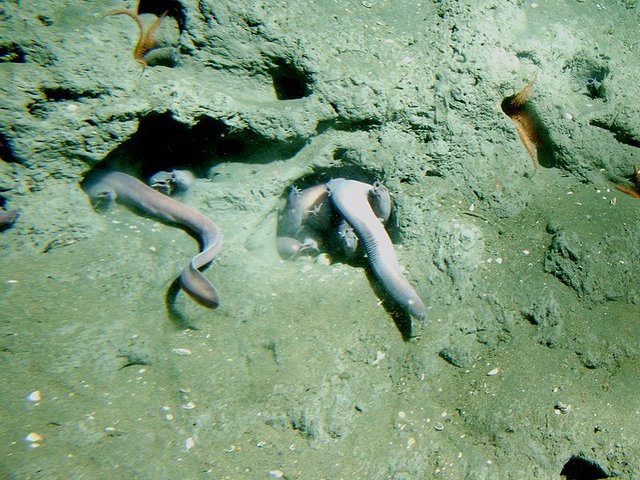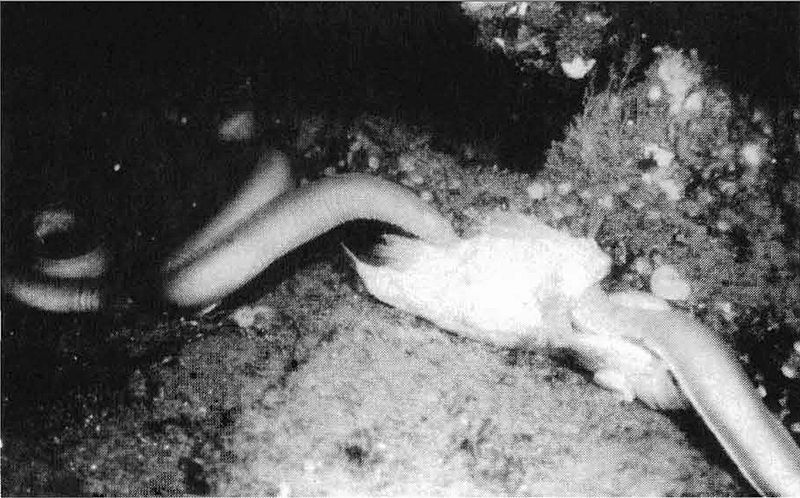LIVING PREHISTORIC FISHES - HAGFISH (PART 1)
INTRODUCTION
This post is inspired by @mobbs post about pre-historic lungs and nostrils of fishes. It’s really an interesting read, you should check out his page and read it. After I read his post, I made my way to google to ask certain questions on that post and then I discovered these beautiful species of pre-historic fishes that are still alive today.
It triggered my interest and I decided to carry out a research and well introduce you to these living fossils. I take time to describe them one by one which would make this approach a series. The first pre-historic fish I would identify in this series is the hag fish.
This fish is a very interesting one and it looks like an eel and has been in existence for over 300 million years which makes it a living fossil and of great significant to the scientists. Also, they produce a very high amount of slime which is also important to scientists as they plan to use it as a biomaterial in the future.
SCIENTIFIC CLASSIFICATION
Kingdom: Animalia
Phylum: Chordata
Subphylum: Vertebrata
Superclass: Cyclostomata
Class: Myxini
Order: Myxiniformes
Family: Myxinidae
Rafinesque, 1815
DESCRIPTION OF THE HAGFISH
The hagfish is a fish that looks like an eel. It is jawless, boneless with a false vertebral column. and it produces slime. It doesn’t have a jaw and has no bone. Interestingly scientists say that this species of animal or fish is actually the only living animal that has a skull but doesn’t have a vertebral column.
This fish has a cartilaginous skeleton and shares almost the same physical characteristics with its ancestors from 300 million years ago.
It is scaleless and also it lacks fin. You may be wondering how this guys swim. Well they use their tails to aid movement in the water. It does not have scales on its body.The hagfish has a mouth but doesn’t have a lip. You would say this fish really has a lot not put in place.
This mouth forms a star-shape when it is closed. It has horny like teeth that surrounds its tongue (these teeth are rasp-like and are in rows). The teeth protracts and retracts and in the process drags it’s food into the pharynx.
They are usually 19.7 inches in length but Eptatretus goliath a hagfish species was recorded to be 4 feet 2 inches in length which made it the the largest known specimen of this species of fish.
Other specimen like the Myxine kuoi and Myxine pequenoi was recorded to have grown to only 7.1 inches in length with some recorded to be as small as 1.6 inches. They have an eel-like body which is elongated with a tail that it uses to paddle it’s way around the sea.
Their colors ranges according to their species from pink to blue-grey, and sometimes black or white spots may be seen. They do not have compound eyes but eyespots which makes them somewhat blind. They do not have fins and they possess only one nostril.
HABITS
The hag fish loves staying at the bottom of the water where there is soft mud. It spends a lot of time engulfed in soft mud or clay with the tip of its snout projecting outward. The hag fish is a top scavenger and rarely prey on small sea animals. They love to feed on dead animals.
The hagfish is somewhat blind as I said earlier which might make you wonder how it finds these dead aquatic animals and feeds on them. Well, the hagfish has a very specialized olfactory device. It feeds majorly on dead fishes or disabled ones.
They are very aggressive in feeding on this dead fishes. They feed on its intestine first before proceeding to eat all of the flesh leaving bare skin and bones. It is also known to prey on annelids in the Norwegian waters. The hagfish constitutes nuisance in the sea by excreting a large amount of slime from it mucous sac.
The hagfish goes to the depths of 10 to 20 fathoms or even more during the summer to stay at a low temperature or probably cooler.
REPRODUCTION
The hagfish was formally thought to be a functional hermaphrodite. This was because of its single sex organ which produced sperm at the posterior portion and then produces egg later in the anterior portion. But recent studies has made it known to us that they are not really hermaphrodites.
It was discovered in this study of the hagfish sex organ that the male organ of the common sex organs is functional while the female sex organs doesn’t mature or function at all and vice versa.
The female lays about 19-30 eggs with the individual egg size of 25mm in length. When the females lay this egg, they deposit it at the bottom where they stick to fixed object with thread of slime or their terminal filaments.
The female hagfish stops feeding when its close to her sexual maturity just like many other fishes do. The hagfish eggs was reported to be found at depth of 50-150 fathoms covered with soft mud or sand bottom. According to scientists the hagfish that has just been newly hatched have never been seen.
The smallest hagfish seen was recorded to be about 2 and half inches long in length which was probably not long after it hatched, it already had a very close resemblance with the adult hagfish when you look at its morphological characteristics.
FEEDING
The hagfish feeds majorly on carrions and are very aggressive when the feed. They are known to devour these carrions from the inside more specifically, they eat the intestine and then proceed to eating all the flesh available leaving behind just bones and bare skin.
These species of fish also feeds on annelids. They are able to absorb dissolved organic substance across their skin and gills which maybe an adaptation to their kind of life style(scavenging) and also maximize their chances of eating well.
The hagfish has a very slow metabolism which makes it stay alive a couple of months between feeding. They prey on hermit crabs, bony fishes, whale flesh etc according to the results gotten from the analysis of its stomach content.
The hagfish use their slime sometimes to suffocate its prey to death before devouring it. They use the overhand-knot behavior when they are in captivity to enable them gain mechanical efficiency to pull out loads of flesh from the carrion of fish or cetaceans. This results in the creation of an opening that enables them devour deeper into the prey’s body.
PRODUCTION OF SLIME BY THE HAGFISH
The hagfish excretes large quantities of slime from multiple glands running alone their flanks. This slime is usually milky and fibrous in nature and these glands which secretes them are about 100 or more.
A particular species of hagfish (Maxine glutinosa) got its name for this slime. When they are held in captivity they tend to secrete a very large amount of slime that can explains up to 20 liters of a very sticky and gelatinous substance when it is combined with water.
They also secrete slime as a defensive measure in escaping from the hands of predators and also suffocate preys to death. It also blocks the predators nostrils and makes it hard for the predators to breath forcing the predators to let go of it in order to stop suffocation and death.
The production of this mucus or slime by the hagfish actually reduces the number of predators the hagfish has. This of course is an advantage for this eel-like fish. Hagfish that are not captured also secretes slime when they feel threatened in the sea but they later clean it up by the traveling-knot behavior.
PROFITABLE USE OF THE HAGFISH
___
The Koreans are the major consumer of this fish. The inshore hagfish that’s lives in the northwest pacific is the specific hagfish that is eaten by the Koreans.
The hagfish is captured and put in a container and disturbed so it could produce slime in very large quantities.
This slime is utilized like the way egg whites are utilized in cooking by the Koreans. The inshore hagfish is identified as kkomjangeo (꼼장어) or the meokjango (먹장어) in Korean language and its known as nuta-unagi (ぬたうなぎ) in Japanese. This species of hagfish is the only known member in the family with a seasonal reproductive cycle.
The hagfish skin is used in the production of very durable leather for further production belts, wallets etc. The skin can also be used in the textile industry to produce clothes that are referred to as eel-skin clothing.
WHERE CAN THE HAGFISH BE FOUND GENERALLY ?
The hagfish are found in both coasts of the North Atlantic Ocean and they could also be seen in the arctic seas.
CONCLUSION
- The hagfish is a living fossil as it’s been in existence for more than 300 millions years.
- It secretes a lot of slime which could be used in the production of biomaterial in the future
- They are very aggressive eaters and feed mostly on carcasses. They are basically scavengers.
- They are valued as food in Korea and have significant commercial use.
- They have a skull but lack a vertebral column. They are also jawless.
REFERENCES
DESCRIPTION OF THE HAG FISH
FEEDING HABITS
HABITS AND SLIME DEFENSE MECHANISM
REPRODUCTION
COMMERCIAL USE AND SCIENTIFIC CLASSIFICATION OF HAGFISH
IMAGE SOURCES
All images used here are from free sources and are liable for commercial use all licensed under the Creative Commons.





Here we have a creature that has been around for over 300 million years, and of all the invaluable importance this creature represents, we decided to have them for dinner.
I am sure planet Earth and all it's inhabitants (except man, obviously)are rooting for humanity to go extinct, and clearly, I don't blame them
Great post by-the-way @florae
Thank you 😊
Your Post Has Been Featured on @Resteemable!
Feature any Steemit post using resteemit.com!
How It Works:
1. Take Any Steemit URL
2. Erase
https://3. Type
reGet Featured Instantly & Featured Posts are voted every 2.4hrs
Join the Curation Team Here | Vote Resteemable for Witness